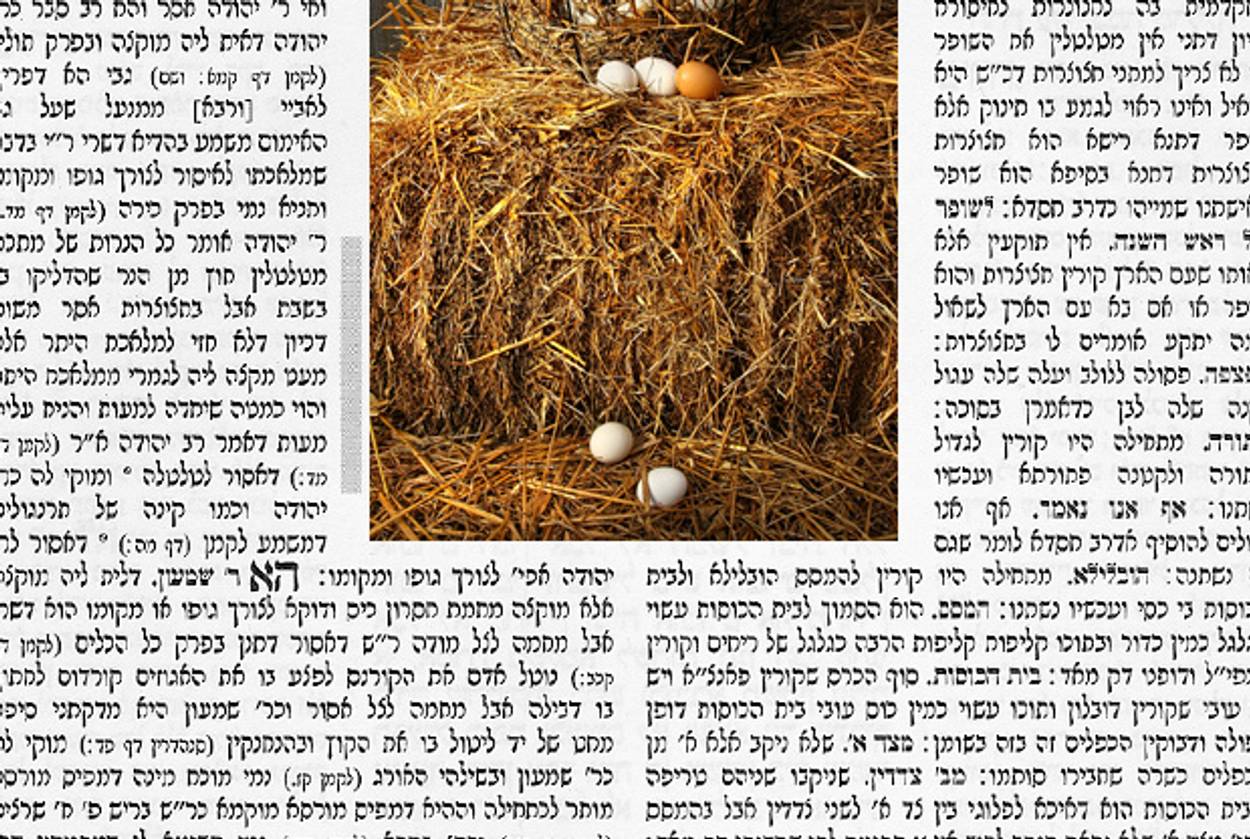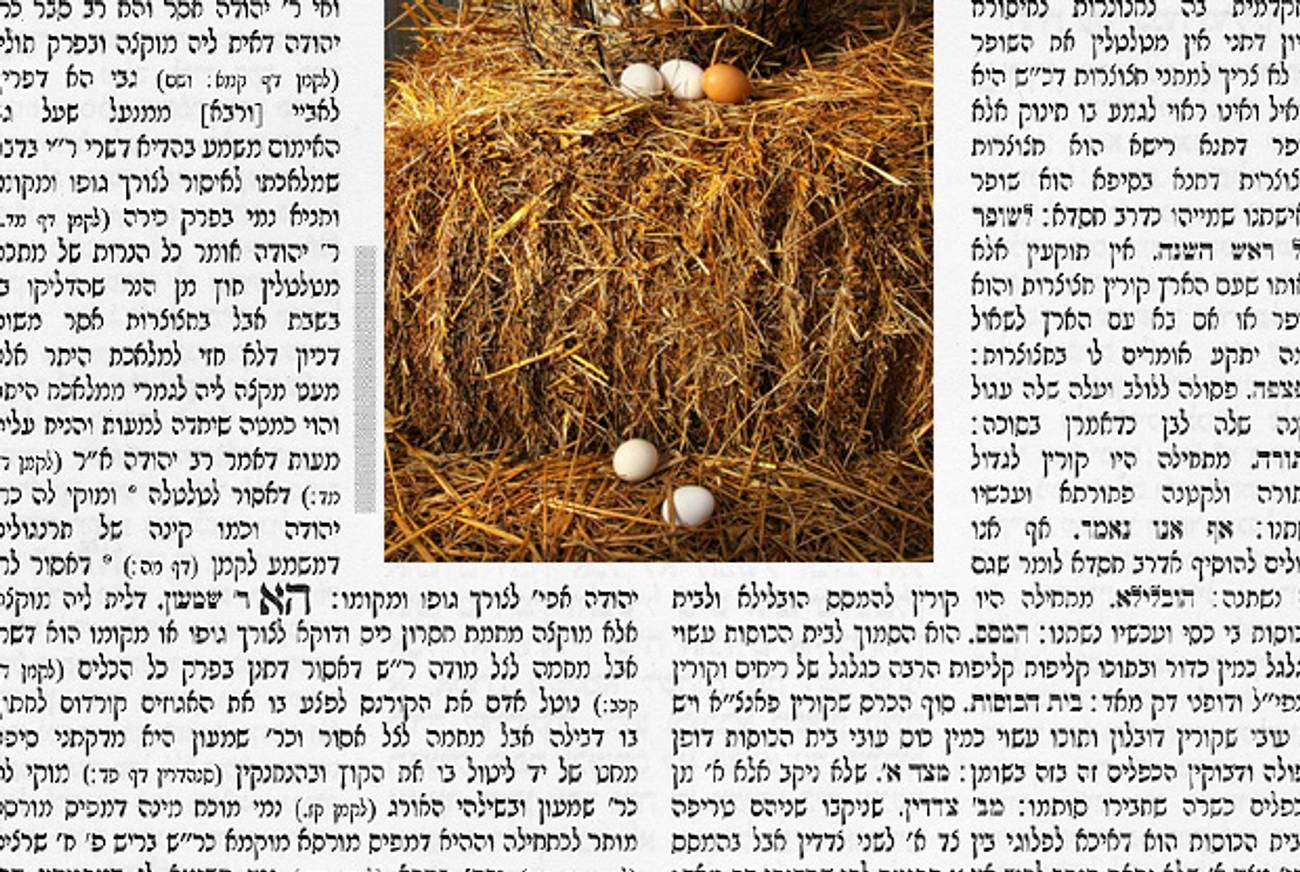Eggs and Babies
This week’s Talmud study reveals legal debates that refine the limits and nature of inherently abstract concepts




Literary critic Adam Kirsch is reading a page of Talmud a day, along with Jews around the world.
This week’s Talmud reading was largely devoted to the legal concept of muktzeh, a category of items that may not be moved or used on Shabbat. It is a fairly technical discussion, but in the course of it, in Shabbat 43b, the Talmud comes up with a bizarre image that makes all the abstractions immediately memorable: a baby or a loaf of bread placed deliberately on top of a dead body. This is Rav’s solution to one of the difficult Shabbat-related cases the rabbis consider: What can you do on Shabbat with a corpse that is decomposing in the sun? “One should place a loaf of bread or an infant on the corpse and then move it,” Rav says.
To understand how he came up with this macabre recommendation, it’s necessary to go back to the beginning of the rabbis’ discussion of muktzeh. The principleis that the only objects one is allowed to handle on Shabbat are those that have been explicitly or implicitly prepared for use on the holy day. The origin of this rule lies in Moses’ instructions to the Israelites concerning the gathering of manna in the desert. The day before Shabbat, the people were instructed to gather a double portion of manna and “prepare” it for the next day. By extension, the Oral Law insists that only “prepared” items are fit for Shabbat; everything else is muktzeh, “set aside.” The Talmud’s examples include oil dripping from a lamp, an egg newly laid by a hen, money, and a corpse; all are considered muktzeh and cannot be used or moved.
The rabbinical debate recorded in this week’s Daf Yomi reading has to do with the proper scope of muktzeh. In Shabbat 42b, a mishnah instructs that on Shabbat it is forbidden to “place a vessel under a lamp to catch the dripping oil in it.” The reason is that the oil is muktzeh, and it is forbidden to move a non-muktzeh vessel for the sake of something that is itself muktzeh. Taking this as a precedent, the rabbis of Gemara go on to consider a more difficult case. What about an egg that a chicken lays on Shabbat? By definition, the egg can’t be considered prepared for Shabbat, since it did not exist before Shabbat; it belongs to a type of muktzeh item called nolad, “just born.”
What happens, then, if a chicken lays an egg on Shabbat and you are afraid that someone will accidentally step on it? Are you allowed to catch the egg in a basket as it comes out? By analogy with the Mishnaic example, the rabbis argue that this is prohibited: Just as you can’t use a non-muktzeh vessel to catch muktzeh oil, so you can’t use a non-muktzeh basket to catch a muktzeh egg.
But, Rav Chisda adds pragmatically, you can put a basket over the egg so that it doesn’t get broken. This is because “the rabbis allowed precautions that are needed to prevent commonplace losses, but they did not allow taking precautions that are needed to prevent uncommon losses.” It is common for a chicken to lay an egg on a flat surface, where it could be protected by a basket. But it is uncommon for a chicken to lay an egg on an inclined plane, where it could roll and be cracked; so it is forbidden to take precautions to prevent such a loss, say by catching the egg in a basket in the first place.
This may seem like a trivial problem, but it’s plain enough that the rabbis are not going to such lengths to define muktzeh because of their concern for egg production. Rather, this homely example is being used to demonstrate the limits and nature of an inherently abstract concept. And the discussion that follows shows how much the rabbis enjoyed the sheer intellectual work involved in refining that concept as well as the cut and thrust of legal debate.
The Gemara records a long exchange between Rabbah and Abaye in which they duel over the question of how to define an “uncommon loss.” Abaye cites a baraita that states that if a barrel of wine or oil breaks on your rooftop on Shabbat, you are permitted to use a vessel to catch it. Surely such an event qualifies as uncommon, yet here the authorities allow us to use a non-muktzeh vessel to catch muktzeh liquid. Isn’t this a contradiction of the earlier ruling, which allows such an action only in case of “common losses”?
The law is concerned with what you do, not why you do it.
But Rabbah has an answer ready. The breakage is not actually uncommon, because the baraita here is talking about “new earthenware kegs, which frequently burst.” Abaye returns to the attack: According to the Mishnah, “we may invert a bowl over a lamp in order that it not set fire to an overhead beam.” Surely such a fire is uncommon? No, Rabbah retorts: This mishnah was talking about “houses that have low ceilings, in which fires are commonplace.” What about the rule that if a roof beam breaks on Shabbat you are allowed to support it with a bench or a bed? Rabbah is prepared again: This rule has in mind “new beams, which often break.”
And so on, for several paragraphs. In each case, the concern of the rabbis is to harmonize their sources. If one Tanna seems to authorize what another prohibits, there must be a catch somewhere, and the rabbis’ imagination and ingenuity are brought to bear on finding it—or, as it sometimes appears, inventing it. For me, as I imagine for many modern readers, Rabbah’s arguments seem a little too convenient. But if you begin, as the rabbis did, with the principle that the law cannot contradict itself, then Rabbah’s argument is not just acceptable, but highly meritorious, since it preserves the agreement of the Tannaim.
It is this same ingenuity that leads to the odd case of the corpse with a baby on it. A corpse, naturally, is muktzeh—it would have to be, since there is no possible use for it. And the law states that we are not allowed to move muktzeh items on Shabbat. This would leave you in a difficult situation—especially in the hot climate of Palestine or Babylonia—if you were stuck on Shabbat with a corpse sitting out in the sun. Can the rabbis come up with a way around the prohibition, which would allow moving the corpse into the shade?
In fact, they offer several solutions. You could put up an awning over the corpse—on the condition that the awning also protects a living person from the sun. In that case, the awning would be considered for the sake of the living person, not for the sake of the dead one, who is muktzeh. (Remember, it is forbidden to move something non-muktzeh, like an awning, for the sake of something muktzeh.) Alternatively, you could roll the corpse over from one bed to another, until it reaches the shade; the justification here, according to Rashi, is that “one is not moving the corpse in the usual manner.”
Finally, Rav suggests, “One could place a loaf of bread or an infant on the corpse and then move it.” This is because, in such a case, the most important thing being moved would be the bread or the child, which are highly non-muktzeh; the corpse would be considered ancillary. So the reasoning goes, at least. But this seems highly vulnerable to the objection that, in fact, moving the corpse really is the whole point of the exercise—if it weren’t for that, the child or the loaf would never have gotten involved in the first place. Here again—as in the earlier discussion of transfers on Shabbat—the Talmud seems strikingly indifferent to motive; the law is concerned with what you do, not why you do it. This attribution of purity and impurity, not to motives, but to objects and actions is perhaps the most difficult thing for me to wrap my mind around, even in the thorniest Talmudic discussion.
***
Like this article? Sign up for our Daily Digest to get Tablet Magazine’s new content in your inbox each morning.
Adam Kirsch is a poet and literary critic, whose books include The People and the Books: 18 Classics of Jewish Literature.
Adam Kirsch is a poet and literary critic, whose books include The People and the Books: 18 Classics of Jewish Literature.